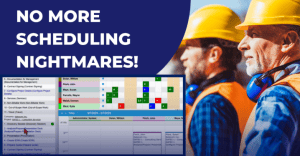Written by Ryan Grundy
As a small business owner, you probably use spreadsheets for many of your processes. These might include Excel spreadsheets, Google Sheets and other spreadsheet tools that allow you to store data and handle day-to-day management tasks.
While spreadsheets can be powerful, software solutions are increasingly helping businesses accomplish these tasks more efficiently, securely and with greater data integrity. Many software features are now cloud based, supporting real time updates and drastically reducing human error and the learning curve often associated with complex data management.
In this article, we discuss the pros and cons of using spreadsheets for your business processes and why dedicated software may be a better choice. We’ll also highlight key differences you should be aware of when comparing spreadsheets to project management or accounting software.
The productivity challenge
Historically, small businesses have used Excel spreadsheets as a default tool, only adopting other software as their operations grew more complex. However, juggling multiple users within a spreadsheet can lead to confusion, manual entry mistakes and time consuming processes.
As cloud computing and other technologies have become more accessible, software—including cloud accounting, field service management, payroll and HR solutions—has expanded your options to streamline business processes. These advanced solutions function like relational databases, offering features that handle complex data and reduce errors.
For businesses aiming to work productively, spreadsheets have significant disadvantages. Studies show that up to 88% of spreadsheets contain errors, which can cause major headaches and waste time and resources. Additionally, 35% of companies have reported discrepancies in their most important spreadsheets.
In contrast, dedicated software is designed to reduce errors, speed up processes and support mobility, compliance and security. It can often function as a real time database, making data analysis more intuitive.
Advantages of spreadsheets
For basic tasks like inputting and organizing data, spreadsheet software remains one of the most accessible and user friendly tools. Spreadsheets allow businesses to store data in rows and columns, which is helpful for simpler processes that don’t require relational databases.
Advantages include:
- Making large amounts of data easier to view, manage and analyze
- Creating visual presentations using charts, graphs and tables
- Automating repetitive calculations with formulas
Liam Bastick, director at SumProduct, says: “The biggest areas where businesses still use spreadsheets are as databases and for forecasting and budgeting.
But more dedicated accounting software is gaining ground in small businesses for those who want to create financial statements and use visualization tools—the software does it for them.”
Disadvantages of spreadsheets
For more complex data tasks, spreadsheets are limited in capability and usability. They become more difficult, time consuming and prone to error compared to using dedicated solutions like accounting, field service, payroll or HR software.
Main disadvantages include:
- Learning formulas requires training and can still be challenging
- Errors in formulas or data cells affect all related calculations, which can be time consuming to fix
- Collaboration is tricky, especially when users download live files, make changes and create multiple versions
- Storing data locally risks loss due to hardware failure, and others may not have access when needed
- Multiple users can quickly create conflicting documents, errors, hard-to-use templates and delayed analysis
- Spreadsheets can create compliance risks with certain regulations and requirements
When you consider the limitations, it becomes clear that using spreadsheets for advanced tasks like project management or data analysis can impact accuracy, safety and scalability.
Advantages of software over spreadsheets
Cloud accounting, payroll and HR software eliminate complex calculations, manual data entry and repetitive spreadsheet tasks by organizing information in one central system. This enables business owners to speed up processes and make decisions quickly. Many modern solutions also function as relational databases, maintaining data integrity across all stored information.
Professional software is tested for errors to minimize human mistakes. This includes integrations where your Excel or Google Sheets data can be synced into a central database tool.
These benefits dramatically reduce the time spent on manual processes. Unlike spreadsheets, software provides built-in analytical tools, offering valuable insights on sales performance, purchase trends and demographics.
This helps you serve your customers better, identify and correct mistakes and refine your budgets. Advanced features such as real time dashboards provide user friendly tools that go far beyond the capabilities of standalone spreadsheets.
6 Important Reasons Why Software Beats Spreadsheets
Managing invoices
- Compared to spreadsheets, professional accounting software allows for fast and simple data entry and retrieval, saving you time and effort when creating invoices. If you’ve used spreadsheet invoice templates, you know how quickly a small error can escalate.
Software reduces errors by guiding you to enter information in the correct format at the right time. Data in these systems often updates in real time, supporting better integrity.
Spreadsheets often cannot upload information automatically from other sources, such as your bank, or reconcile it. Accounting software provides everything you need to create and send invoices, track payments, get bank feeds, automatically reconcile with your bank and calculate and submit VAT returns.
Accounting software can also generate branded, professional invoices, quotes and estimates for your clients. Software integrations ensure everything ties together, eliminating the need to manage separate solutions.
Capturing receipt details
- If you keep multiple spreadsheets, finding information about expenses or suppliers can be difficult as you search through receipts stored in various locations. This is especially true if you use a mix of Excel, Google Sheets or other spreadsheet tools.
With accounting software, you can retrieve information and report on it easily. Robust project management or finance features mean everything is saved in one system, so you don’t have to jump between different spreadsheet programs.
Some software integrates with receipt apps, allowing you to take photos of receipts with your phone and record transactions quickly. This reduces manual data entry and helps maintain data integrity.
Managing budgets
- While businesses still use spreadsheets for planning, many quickly find themselves in ‘spreadsheet hell’ with multiple versions and conflicts. This can be worse when dealing with complex data or budgeting tasks that might require a more robust solution.
To cut costs, you could search through spreadsheets and model wage and overhead data, but this is time consuming and much easier to do in cloud accounting software integrated with your accounts.
Software enables collaboration on budget plans in a single, secure application. This eliminates inefficiencies and security risks, as you no longer need to share multiple versions of sensitive information via email. You simply make changes once.
Accounting software speeds up the budgeting process, so changes take seconds rather than minutes, giving you more time to focus on your business. Software also allows you to combine and query information more quickly, reducing errors and duplication.
The result is a more dynamic budgeting and planning process, with cash flow forecasts and scenarios run quickly and with minimal training. Thanks to cloud updates, you’ll see real time data changes without the typical learning curve of advanced spreadsheet methods.
Accounting software also provides a real time view of performance, enabling you to respond rapidly to market changes. This is especially helpful for project management tasks where you need updated financial data at any moment.
Tracking payments
- Most spreadsheets are not designed to record payments or alert you to late payments automatically. Professional accounting software is programmed to do this, making the tedious job of tracking unpaid invoices much easier.
Most spreadsheets do not offer automated bank feeds, which help you integrate income data from your bank and save hours reconciling statements. In many cases, you’d rely on manual entry or complex formulas, increasing the time required.
Accounting software records payment information against customer accounts automatically. It also allows you to track invoice payments remotely via your mobile phone, which is difficult with most spreadsheets.
By using one database for all transactions, you reduce the risk of error, increase data integrity and keep your project management tasks running smoothly.
Submitting returns and keeping business records
- Unlike spreadsheets, professional accounting software can be used to submit your tax returns directly to authorities. This saves time, keeps track of your records and ensures analysis is conducted in one integrated tool rather than across scattered files.
The software is updated as rules and regulations change. It automatically retains all records that authorities might need and sends information in the correct order, reducing the chance of an audit.
Accounting software is designed to reduce errors, making record-keeping less of a headache. The theft, abuse or destruction of your spreadsheets could be devastating for your business.
Cloud based accounting programs keep your data safe on secure, off-site servers, meaning it’s always recoverable. This ensures your valuable data remains protected, removing worries about restoring information from local copies.
Scheduling shifts
- Tracking and managing staff shifts in various locations can be cumbersome when it involves endless emails and multiple spreadsheets. This is even harder as more people work remotely, especially since many spreadsheets are not cloud based or mobile friendly.
Professional cloud HR software addresses these challenges as it’s easy to use on any device and maintains one version of the truth. You can create and edit shifts, track schedules, holidays and sick leave, and approve time-off requests quickly from anywhere. For advanced project management, integrated solutions often include time tracking and resource allocation.
Employees can access everything they need—including schedules, pay slips and company policies—log time, request leave and check holiday balances. Centralized data ensures everything is organized in a single location for multiple users to access securely.
HR software offers more automation compared to spreadsheets, such as pre-filling hours with time-off data and merging approved timesheets for payroll reports. It provides all the tools needed to organize your workforce remotely, including communications, reporting, asset management and charts.
Final thoughts
Small businesses benefit greatly from technology. Providers are meeting this need by increasing the functionality, accessibility and affordability of their products.
While spreadsheets still have their uses, when it comes to reducing manual processes, keeping accurate records and working anywhere at any time, software can significantly speed up your business.
This leaves you with more time to focus on what you enjoy and add value to your business. As relational databases and integrated management software become increasingly important for data analysis and project management, you may find that software delivers meaningful improvements, addressing many of the key differences between a simple spreadsheet and a true database solution.




